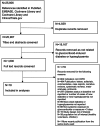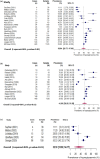Glucocorticoid treatment and new-onset hyperglycaemia and diabetes in people living with chronic obstructive pulmonary disease: A systematic review and meta-analysis
- PMID: 39642210
- PMCID: PMC11823367
- DOI: 10.1111/dme.15475
Glucocorticoid treatment and new-onset hyperglycaemia and diabetes in people living with chronic obstructive pulmonary disease: A systematic review and meta-analysis
Abstract
Introduction: In people living with chronic obstructive pulmonary disease (COPD), we aimed to estimate: (1) the prevalence of glucocorticoid-induced hyperglycaemia (GIH); (2) whether the prevalence of GIH varies by age, baseline diabetes status, treatment duration, ascertainment of glycaemia, definition of hyperglycaemia, study design and year of publication; and (3) the relative risk (RR) of new-onset hyperglycaemia in exposed vs non-exposed to systemic glucocorticoids.
Methods: We searched electronic databases until 9 November 2023 for randomised controlled trials and observational studies including adults diagnosed with COPD, with or without diabetes at baseline, using systemic glucocorticoids equivalent to prednisolone ≥5 mg/day for ≥3 days if exposed. Hyperglycaemia was defined as a blood glucose above a study-specific cut-off. We extracted data on study and participant characteristics, exposure and outcome. We performed random-effects meta-analysis to calculate pooled prevalence estimate of GIH. Prevalence was expressed as the proportion of people who developed hyperglycaemia among all exposed to systemic glucocorticoids during follow-up. We calculated RR of new-onset hyperglycaemia in exposed vs non-exposed to systemic glucocorticoids from eight studies.
Results: Of 25,806 citations, we included 18 studies comprising 3642 people of whom 3125 received systemic glucocorticoids and 1189 developed hyperglycaemia. Pooled prevalence of GIH was 38.6% (95%CI 29.9%-47.9%) with significant heterogeneity, I2 = 96% (p < 0.010), which was partially explained by differences in study design. Pooled RR = 2.39 (95%CI 1.51-3.78). Publication bias was present.
Conclusion: The prevalence of GIH was 38.6%. Being treated with systemic glucocorticoids for COPD was associated with 2.4 times higher risk of new-onset hyperglycaemia versus no glucocorticoid treatment.
Keywords: clinical diabetes; diabetes; other complications; systematic review.
© 2024 The Author(s). Diabetic Medicine published by John Wiley & Sons Ltd on behalf of Diabetes UK.
Conflict of interest statement
All authors declare no conflict of interest.
Figures




References
-
- Electronic Medicines Compendium . Summary of product characteristics for Prednisolone 5mg tablets. Accessed 18 Jan 2022. https://www.medicines.org.uk/emc/product/2427/smpc#gref
-
- Perez A, Jansen‐Chaparro S, Saigi I, Bernal‐Lopez MR, Minambres I, Gomez‐Huelgas R. Glucocorticoid‐induced hyperglycemia. J Diabetes. 2014;6(1):9‐20. - PubMed
-
- Umpierrez GE, Isaacs SD, Bazargan N, You X, Thaler LM, Kitabchi AE. Hyperglycemia: an independent marker of in‐hospital mortality in patients with undiagnosed diabetes. J Clin Endocrinol Metab. 2002;87(3):978‐982. - PubMed
-
- Clore JN, Thurby‐Hay L. Glucocorticoid‐induced hyperglycemia. Endocr Pract. 2009;15(5):469‐474. - PubMed
-
- Kwon S, Hermayer KL, Hermayer K. Glucocorticoid‐induced hyperglycemia. Am J Med Sci. 2013;345(4):274‐277. - PubMed
Publication types
MeSH terms
Substances
Grants and funding
LinkOut - more resources
Full Text Sources
Medical

